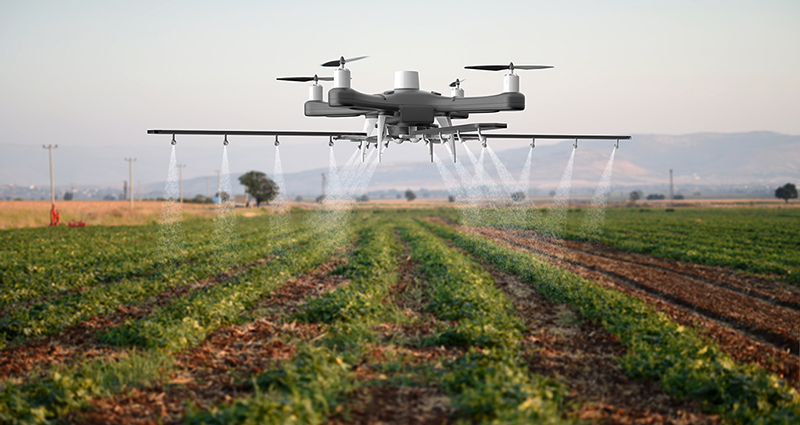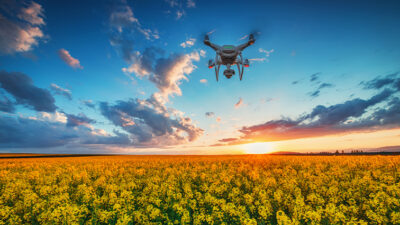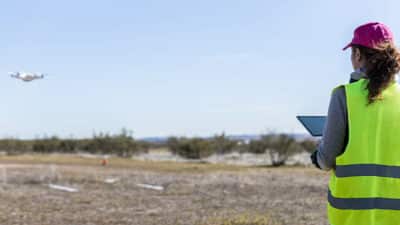The Dawn of Drone Agriculture: Navigating the Skies of Modern Farming

In the past decade, the agricultural industry has seen a significant technological revolution, with the advent of drones, also known as Unmanned Aerial Vehicles (UAVs), being one of the most transformative. These high-flying tools have revolutionized the way farmers and agronomists approach crop management, pest control and land analysis.
However, with the increasing adoption of sophisticated and expensive drones, such as the DJI Agras T40, there are growing concerns over the lack of experience and education among users, which could impact the efficiency, safety and regulatory compliance of drone operations in agriculture.
This article delves into the challenges and needs for standards, training requirements, Federal Aviation Administration (FAA) approvals, awareness and chemical management in the realm of agricultural drones.
The Rise of Drones in Agriculture
Drones have surged in popularity within the agricultural sector for their ability to provide detailed aerial imagery, perform crop spraying and gather data for precision farming. These UAVs offer robust solutions for monitoring crop health, managing irrigation, assessing plant counts and optimizing inputs like fertilizers and pesticides. The DJI Agras T40, for example, is a state-of-the-art agricultural drone designed to spray crops with precision and efficiency.
However, the adoption of such advanced technology comes with a steep learning curve. Operating drones requires a unique skill set that integrates piloting with an understanding of agricultural practices. The potential of these tools can only be fully realized when the operators are well-versed in both the technical and practical aspects of drone usage in farming.
The Need for Standards and Training
The complexity of operating agricultural drones underscores the need for industry standards and training programs. Many farmers and agronomists who purchase drones do so without prior flying experience or knowledge of the intricate systems that govern their operation. This gap can lead to inefficiencies, accidents and even legal issues should the drones be used improperly.
To address this, farmers need to understand the importance of drone training that encompasses not only the basics of drone piloting but also the integration of UAV technology into agricultural practices. Comprehensive training should include flight training, data analysis, maintenance and the application of agricultural principles through UAV technology.
FAA Approvals and Regulations
In the United States, the FAA is the governing body responsible for regulating all civil aviation, including drones. To legally operate a drone for commercial purposes, such as farming, operators must obtain a Remote Pilot Certificate by passing the FAA’s Part 107 test. This certification ensures that drone pilots have a fundamental understanding of airspace regulations, weather effects, drone performance and responsible piloting practices.
Additionally, the FAA has specific guidelines for agricultural drone use, such as restrictions on flying over people, maximum altitude limits and daylight operation requirements. It is paramount for drone operators in agriculture to be well-informed of these regulations to avoid penalties and to ensure the safety of their operations.
Awareness and Responsible Use
Beyond regulations, there is a pressing need for increased awareness among farmers and agronomists about the capabilities and limitations of agricultural drones. Understanding what drones can and cannot do is essential for setting realistic expectations and achieving desirable outcomes. For instance, while drones can efficiently spray crops, they may not be suitable for all types of terrain or weather conditions.
Drone vendors and agricultural extension services have a role to play in educating their clients about the appropriate use of UAV technology. Workshops, seminars and on-site demonstrations can serve as platforms for spreading awareness and sharing best practices in drone agriculture.
Chemical Management and Environmental Considerations
One of the most promising applications of drones in agriculture is the precision spraying of pesticides, herbicides and fertilizers. Drones like the DJI Agras T40 are designed to deliver chemicals in a controlled and targeted manner, reducing waste and minimizing environmental impact. However, without proper training and knowledge, there is a risk of misuse, potentially harming crops, soil, water sources and non-target organisms.
Operators must be educated on chemical management, including the selection of appropriate formulations, adherence to label rates and the timing of applications to ensure efficacy and safety. Moreover, drone pilots should be aware of environmental regulations and best practices to prevent contamination and protect the ecosystem.
Conclusion
Drones hold immense potential for advancing agriculture by enabling precision farming, reducing labor costs and increasing crop yields. However, the integration of UAV technology into agriculture must be approached with diligence and responsibility. Establishing standards, requiring thorough training, ensuring FAA compliance, raising awareness and promoting responsible chemical management are all critical steps toward the sustainable and effective use of drones in farming.
As the agricultural industry continues to evolve, it is crucial that farmers, agronomists and drone operators work together to harness the power of UAVs while maintaining safety, adhering to regulations and protecting the environment. With the right approach, drones will not only soar above fields but also elevate the entire agricultural sector to new heights of innovation and productivity.

DARTdrones, the nation’s leading drone training company and Global Aerospace SM4 partner, offers courses in 40+ cities across the U.S. DARTdrones offers basic flight training classes, Part 107 Airman Knowledge test prep courses, advanced industry specific training, and UAS program implementation consulting services. DARTdrones has been helping individuals and organizations develop safe and efficient sUAS programs and continues to keep new and developing safety considerations at the forefront of their curriculum development. For more information, visit us or call the team at 800-264-3907. DARTdrones was featured on ABC’s Shark Tank in February 2017.
https://www.dartdrones.com/
© 2025 DARTdrones. All Rights Reserved.
Next ArticleRelated Posts

Part 108: The Next Step in BVLOS Integration and Drone Innovation
As the drone industry awaits the Federal Aviation Administration’s (FAA) forthcoming Part 108 regulations, the landscape of Beyond Visual Line of Sight (BVLOS) operations stands on the brink of transformation. These anticipated rules aim to standardize BVLOS flights, enabling more complex and expansive drone missions across various sectors.

Beyond Part 107: Enhancing Drone Pilot Skills for Safety and Performance
As a licensed drone pilot, you can fly commercial missions, embark on exciting new adventures, hone your skills and earn money. Your Part 107 license is an important start on your training journey. However, additional training beyond Part 107 is crucial. You should invest in your future and strive to become the best drone pilot you can be!

